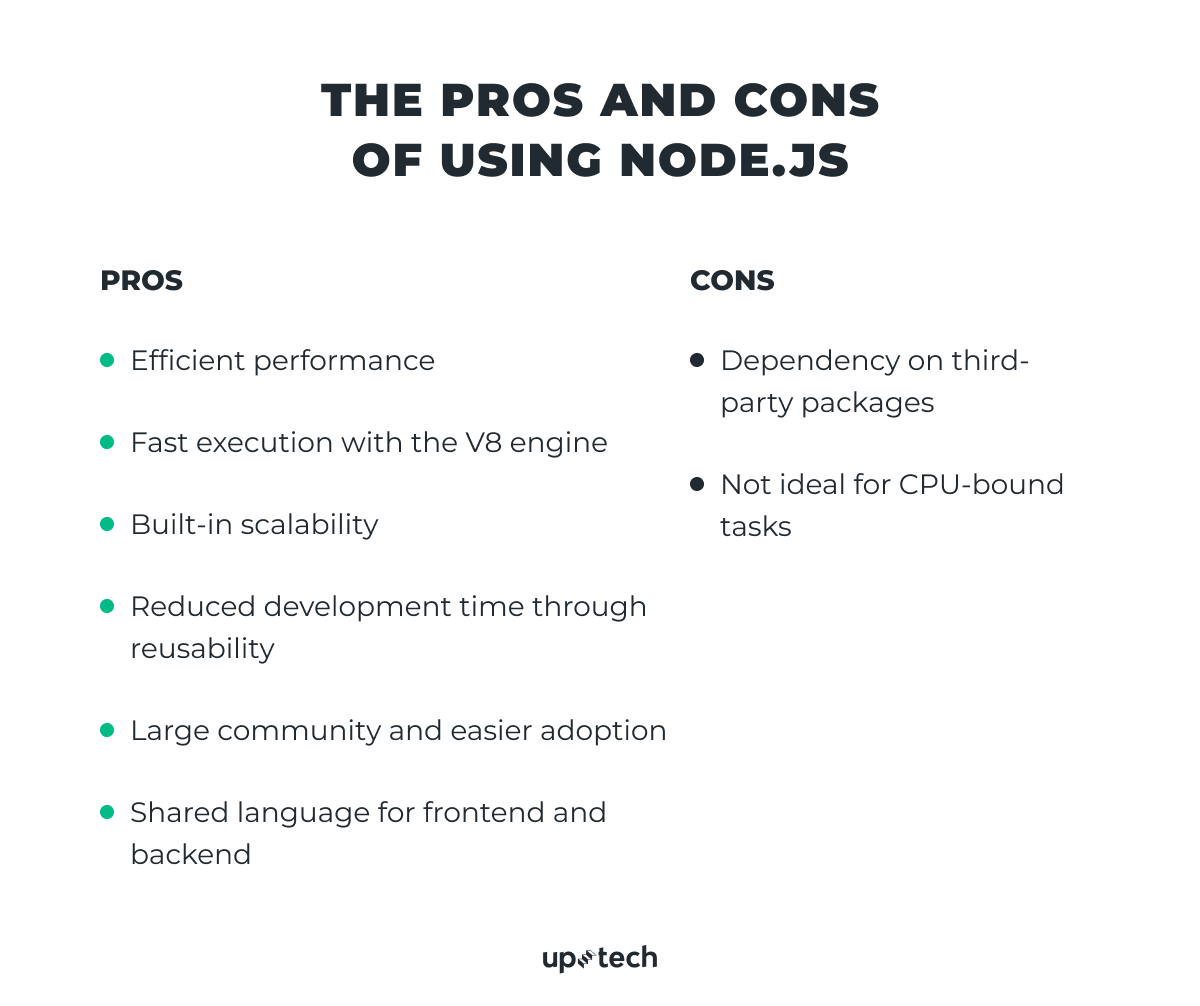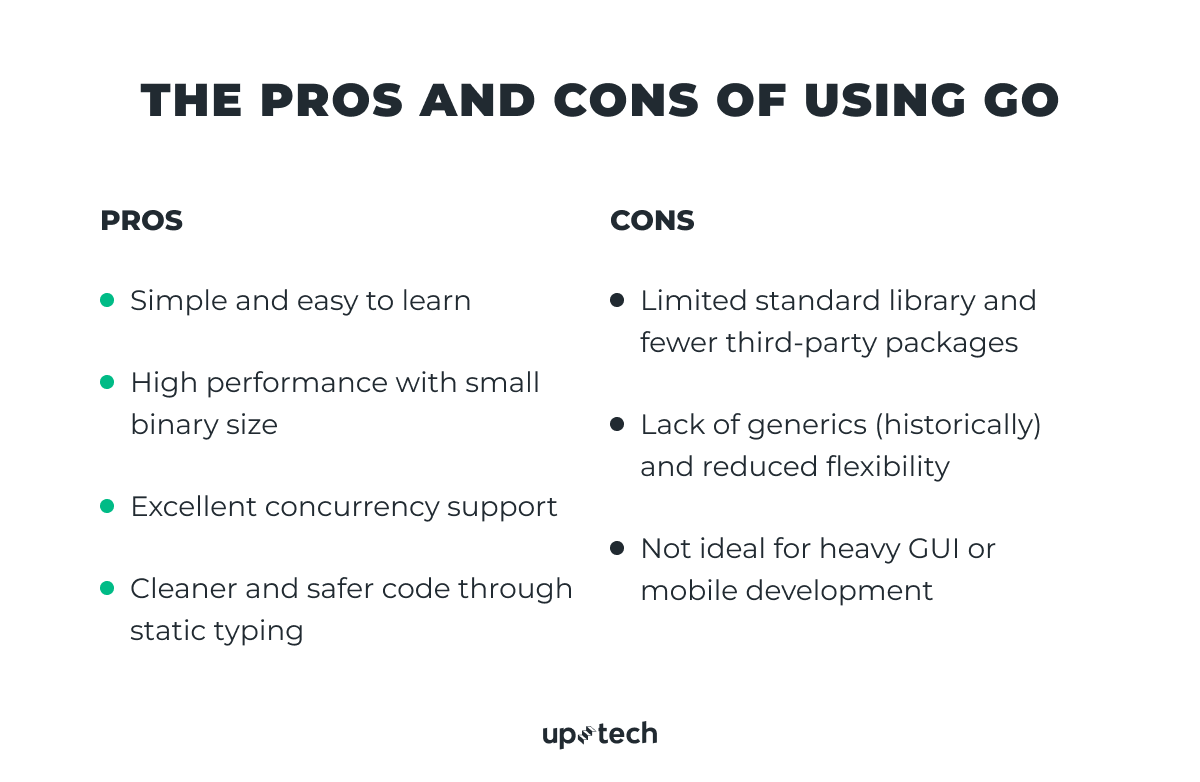When you’re building a web application or website, the front-end UI is only a part of the equation. What’s equally important is getting the back-end logic right, which means getting the right tools for server-side development. That’s when the battle of Node.js vs Go becomes interesting.
Both Node.js and Go are popular among developers, but which is best for back-end development? How do both back-end programming languages compare against each other?
Read on and find out which is the best fit for your project.
What Is Node.js?
Node.js is an open-source JavaScript runtime environment that was introduced in 2009. It was built on libuv for asynchronous IO support and the V8 JavaScript engine to execute JavaScript as standalone applications. Node.js extends the limits of JavaScript beyond web browsers, and it’s great for building server-side business logic.
Since its introduction, Node.js’s popularity has grown leaps and bounds. Node.js uses an event-driven, non-blocking I/O architecture that allows developers to build highly scalable applications that are both lightweight and fast.
In addition to server-side development, Node.js is commonly used to build command-line tools and even desktop applications, thanks to its ability to run JavaScript outside the browser.
Today, companies like Netflix, Trello, and LinkedIn are using Node.js in their applications.
According to the Stack Overflow Annual Developer Survey, Node.js remains one of the most popular technologies, with 48.7% of respondents choosing it.

What Is Go?
Go, or Golang, is a statically-typed programming language designed at Google by Robert Griesemer, Rob Pike, and Ken Thompson in 2007 and publicly introduced in 2009. It is open-source, and its syntax bears similarity to C. However, Go is a more polished and disciplined language as it allows for safer memory usage, object management, and better garbage collection.
Go is favored for its speed and efficiency. Code written in Go is compiled directly into machine code without the need for an interpreter like some scripting languages. This means Go packs the raw power required to handle computationally-intensive tasks.
The language includes native mechanisms for concurrent programming with goroutines and channels, which developers often use in large or distributed systems.
Go is commonly used to build backend services, cloud platforms, networked applications, and command-line tools.
Go vs Node.js: The Pros and Cons of Each
Go and Node.js often appear side by side in backend development discussions, but they are not the same type of technology. Go is a statically typed programming language, while Node.js is a JavaScript runtime environment that allows developers to run JavaScript outside the browser.
Even though they operate on different levels, teams frequently evaluate them together because both are used to build modern backend systems, from APIs and microservices to high-load and real-time applications.
It's also worth noting that these technologies do not exclude one another; many companies use Go and Node.js side by side, choosing each for the tasks it handles best.
In the next section, we break down the pros and cons of Node.js and Go to help you understand where they fit best.

The pros of Node.js
Being one of the most widely used backend technologies, Node.js offers several strengths that make it a solid choice for modern applications.
Efficient performance
Efficiency is one of the main strengths of Node.js. The technology can handle multiple requests simultaneously, thanks to its non-blocking nature. Small tasks are executed in the background, which leaves the main thread unaffected.
Fast execution with the V8 engine
Node.js runs on the Google V8 JavaScript engine. The engine compiles JavaScript into machine code, which eliminates the need for an interpreter. Google’s continuous work on improving the efficiency, security, and performance of the V8 JavaScript engine directly benefits Node.js applications.
Built-in scalability
It’s also easy to build scalable applications with Node.js. The platform can handle multiple requests, thanks to its native APIs like clusters, child_process, and worker_threads. These APIs distribute workloads and help reduce CPU strain during traffic spikes.
Reduced development time through reusability
Node.js can also lead to reduced development time as it allows developers to build reusable code or components. As Node.js has a rather sizable community, it means you can use components made by other developers.
NPM, the default package manager for Node.js, gives access to a huge ecosystem of open-source libraries, tools, and utilities that help speed up development. The free npm Registry has become the center of JavaScript code sharing, and with more than two million packages, it is the largest software registry in the world.
Large community and easier adoption
JavaScript is the most popular language amongst developers, which makes picking up Node.js much faster. New developers usually adapt quickly because they already understand the core language. The Node.js ecosystem is also supported by a large global community, which translates into extensive documentation, frequent updates, and easy access to help when needed.
Shared language for frontend and backend
One of the most practical advantages of Node.js is that it uses JavaScript on the server side. Teams can work with the same language on both the frontend and backend, which simplifies communication and reduces context switching. For companies, this often means that one team can cover the full stack without needing separate specialists for each side.
The cons of Node.js
However, like any technology, Node.js also comes with limitations that teams need to consider before choosing it for production workloads.
Dependency on third-party packages
Node.js enjoys a robust ecosystem that’s supported by various open-source tools and libraries. However, it also means a dependency on third-party developers who create these tools. You may encounter reliability and performance issues, as well as a lack of support, when using the tools. This can directly affect the Node.js application development.
Not ideal for CPU-bound tasks
Node.js is built around a single-threaded, event-driven architecture, which works well for handling large numbers of I/O operations. However, it may not be the best fit for heavy CPU-bound tasks such as complex calculations, data processing, or image/video encoding. These operations can block the event loop and slow down the entire application unless they are moved to worker threads or separate services.

The pros of Go
As Go continues to grow in popularity, it offers several advantages that make it appealing for backend and systems development.
Simple and easy to learn
Since Google introduced Go, it has gained wide adoption from developers. Go shines with its simplicity as a programming language. It’s syntactically similar to C, and that means developers can easily master the language without dealing with an overly complex feature set.
High performance with small binary size
Go inherits the benefits of low-level and high-level languages. Go is compiled directly to machine code, and this means you’re getting the best in terms of speed for the application. The compiled binary from Go also has a tiny footprint. At the same time, Go also supports garbage collection, which helps automate memory management without sacrificing performance too heavily.
Excellent concurrency support
With Go, you can handle concurrency better in applications with the available tools. Goroutines allow developers to build multithreaded functions that run concurrently. It’s an obvious advantage to spread out the CPU load and prevent the app from crashing. Channels also help coordinate communication between goroutines, making concurrent code simpler and safer to write.
Cleaner and safer code through static typing
As a statically-typed language, Go produces much cleaner code. Coding errors can be identified during compilation. Also, the garbage collector prevents memory leaks when developers forget to manually release memory from redundant objects.
The cons of Go
Of course, Go is not a perfect fit for every use case. Its simplicity and design choices also create certain limitations that developers should consider.
Limited standard library and fewer third-party packages
There’s a community going on for Go, as well as libraries and tools. Still, it’s a far cry from more-popular languages like Java or Python. The standard library intentionally remains small, which means developers often need external packages for tasks that other ecosystems support out of the box.
Lack of generics (historically) and reduced flexibility
Go avoided generics for many years, which shaped the ecosystem and led to repetitive patterns and workarounds. While generics were introduced in Go 1.18, many existing libraries still do not fully adopt them, and some developers consider the implementation limited.
Not ideal for heavy GUI or mobile development
Go is highly optimized for backend services and systems work, but it is not commonly used for GUI-heavy or mobile applications due to limited framework support.
Where to Use Node.js?
Node.js works well on server-side applications that need to handle multiple requests without burdening the node itself. The asynchronous architecture of Node.js ensures stable connections between the client and server applications.
Node.js is commonly used to build:
- real-time applications (chats, messengers, live feeds)
- online games and multiplayer platforms
- video and audio streaming services
- collaboration tools (shared documents, whiteboards, real-time dashboards)
- REST APIs and backend services for web and mobile apps
- IoT applications that require frequent, lightweight communication
- microservices architectures
- serverless functions and cloud-based event handlers
Its non-blocking model makes it ideal for applications that rely heavily on real-time communication, fast I/O operations, or constant interaction between clients and servers.
Where to Use Go?
Go is meant for applications that are processor-hungry or require multi-threaded tasks. Because Go is compiled, fast, and built around lightweight concurrency, it works especially well for systems that need to process large volumes of data, handle parallel operations, or operate reliably under heavy load.
Go is commonly used to build:
- APIs and microservices
- cloud-native applications (Kubernetes ecosystem, containerized environments)
- high-performance backend services
- network servers and proxies (e.g., load balancers, reverse proxies)
- distributed systems and real-time data pipelines
- command-line tools and system utilities
- DevOps tooling (CI/CD services, infrastructure automation)
Its speed, concurrency model, and compact binaries make it a strong choice for backend infrastructure, cloud platforms, and compute-intensive services.
Node.js vs Go: Ultimate Comparison
Before we get to the details of the Go vs Node.js comparison, it’s important to repeat one key point: Go and Node.js are not the same type of technology. Go is a programming language, while Node.js is a JavaScript runtime environment. Comparing them directly is not fully symmetrical.
The choice is rarely about which one is “better,” but rather which one fits a specific project or architecture.
Performance
Go has a slight edge over Node.js when it comes to raw speed. Go doesn’t need an interpreter and is compiled directly into machine code. This gives Go the same level of performance as low-level languages like C++. In terms of IO operations, Go is on par with Node.js. Both Go and Node.js feature a garbage collector, which helps in preventing memory leaks and ensuring stability.
Node.js is only marginally trailing Go in performance. A much-improved single-threaded Node.js boosts efficiency, and the V8 JavaScript engine ensures that the application runs without the need for an interpreter.
Verdict: Both are fast enough for most backend workloads. Go performs better in compute-heavy scenarios, while Node.js holds up extremely well in I/O-driven applications.
Concurrency
Node.js handles concurrency with APIs like worker_thread, clusters, and child_process. These APIs ensure that Node.js reliably processes incoming requests without running into bottlenecks.
Meanwhile, Go is built to handle concurrent tasks. The use of GoRoutines allows applications to run multi-threaded functions without taking up too much RAM. This makes Go a better candidate for handling processing-intensive tasks without compromising on other functions.
Verdict: Go offers more natural and efficient concurrency, especially for CPU-intensive or parallel tasks. Node.js handles I/O concurrency extremely well, but heavy computation requires additional architecture.

Community
Node.js enjoyed the support of the likes of IBM, Microsoft, and Intel with the OpenJS Foundation. The platform sees hundreds of millions of downloads each year. It’s an indication of how widespread Node.js is and the community’s size that it is actively supporting its usage.
There are signs that Go has matched, if not outpaced, Node.js in terms of popularity. Go is starred by 131k users on GitHub, while Node.js has 115k. Opened pull requests for Node.js and Go are also almost similar. These numbers show that the communities driving the development of both technologies are pretty much equal.
Verdict: Both communities are vibrant. Node.js has a larger ecosystem, while Go’s community is smaller but very active and tightly focused on backend and systems engineering.
Tools and libraries
The presence of ready-to-use tools can reduce development time. Node.js developers have access to more than 2 million open-source tools and libraries via NPM. While there isn’t a shortage of tools for Node.js, choosing the good ones can be tough.
Go does not offer the same quantity of third-party tools, but its standard library is considered powerful and well-designed. Tools like go test, go vet, and go fmt are built in and widely appreciated for improving code quality and consistency.
Verdict: Node.js wins in quantity, while Go wins in built-in tooling quality.
Error handling
Most developers will be familiar with the Node.js error handling method. It uses the try-catch exception where errors are immediately trapped and handled at runtime.
Go, however, checks errors differently during compilation and runtime. Compilation errors are often syntax-related, which can be rectified in code. Runtime error requires explicit handling, where the return value of the function needs to be manually inspected. Work is being done to incorporate better handling in the next version of Go.
Verdict: Neither model is universally “better”; it depends on the team’s preferences and coding style.
Conclusion
It’s hard to draw a conclusion on which is better in the battle of Node.js vs. Go. Both are worthy in their own rights and useful when developing backend applications of different natures. Node.js works well for handling multiple asynchronous requests, while Go provides the much-needed computational power.
At Uptech, our backend developers work with all kinds of backend technologies, whether it’s Node.js or frameworks like NestJS that weren’t covered in this article. We’ve applied these technologies in real-world projects across different industries.
For example, our team leveraged NestJS, TypeScript, and PostgreSQL during the work on MicroGenDX. It is an at-home DNA diagnostics platform with a custom admin panel and native mobile apps for iOS and Android. The project required scalable backend architecture, reliable data processing, and HIPAA-compliant workflows, and today the platform serves both patients and healthcare providers across the US and Europe.
If you have trouble deciding between Node.js and Go, feel free to consult our team at Uptech.




































































































.avif)
